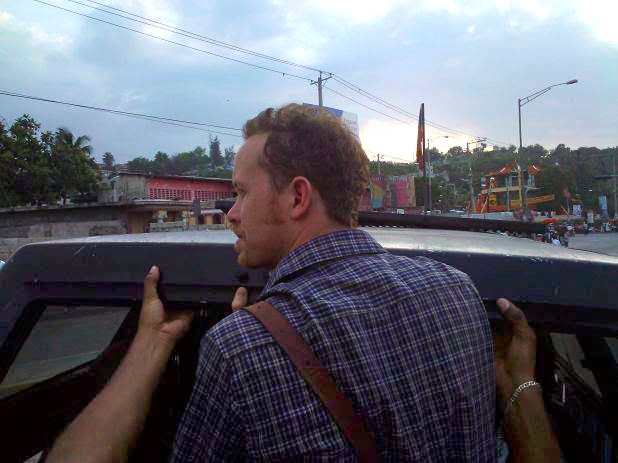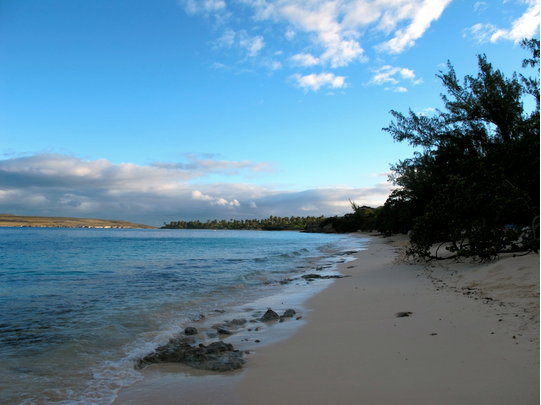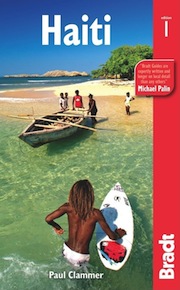We are thrilled to welcome acclaimed travel writer and guide book author, Paul Clammer, to the HaitiHub blog. Paul has traveled, researched, and written about places all over the world including Morocco, Turkey, Pakistan, Afghanistan, Sudan, the Dominican Republic, and Haiti. His most recent large scale book project was Haiti: The Bradt Travel Guide published in 2012, which has achieved wide spread recognition in the travel industry and stands as the most popular Haiti Travel Guide to date.
Byenveni Paul!
During your first visit to Haiti, what struck you most about the country?
This might sound strange, but that it felt like a normal country. Which isn’t to say that Haiti isn’t faced by a whole host of challenges – it is – but that when you start talking to people it’s just like anywhere else: people worry about their job or their kids, talk about music and sports and the rest of it. Buzzfeed had a great piece [http://www.buzzfeed.com/susanaferreira/haiti-raboday-revolution] by Susana Ferreira recently about rabòday – Haitian electronic music. I loved that it just took a completely different narrative from what’s usually written up about Haiti. Of course, politics and aid and the rest of it is important, maybe even more so in Haiti, but that’s a long way from the sum of the story. So yeah, that’s my take: Haiti is normal!
What still surprises you about Haiti?
It’s no surprise to me that Haiti is a beautiful country, but when you travel around there always seems to be some new corner, some unexpected sight to take your breath away. I went trekking by mule in Grand Anse – went up-river, passing bamboo rafts with people taking their produce to market. And all around there were the biggest trees, really beautiful massive forest. And I was thinking, we’re told all this stuff was cut down, but here in this corner at least, Haiti confounds you yet again.
Having traveled to Haiti on several occasions, what do you most look forward to when you return?
Zaboka! I’m an enormous fan of Haitian avocados. If I can throw in a plate of griyo and a bottle of cold Prestige, then I’m a happy boy.

Here, Paul Clammer hangs on to the back of a tap-tap while touring Port-au-Prince. Tap-taps, like motos, are a common form of public transportation in Haiti.
What’s your favorite way of getting around in the country?
Moto-taxis might not be the safest way of getting around, but I’d be lying if I said they didn’t give me a buzz. Much better than spending time in some terrible Port-au-Prince traffic jam too. I wish there was more boat transport though – almost all the departmental capitals are ports, and it would be great fun to hop between them all.
If you were to give us one phrase in Kreyòl, what’s the first thing that comes to mind?
Piti, piti, zwazo fè nich li. I had that in mind a lot when I was researching and writing my guidebook. Little by little, the bird builds its nest!
Have you been able to study Kreyòl as part of your work? If yes, did you see any benefit from it? If no, how did you handle the situations you got into with Kreyòl speakers?
I’ve only done a bit of formal study. My first trip felt like a case of taking my schoolboy French, breaking it up to steal some of the vocabulary, and then building up from there. My Kreyol still isn’t great, but I can’t imagine trying to operate in Haiti without it.
When your friends or family members have been on the fence about visiting Haiti for the first time, what have you told them?
I used to make a habit of writing guidebooks to places like Sudan and Afghanistan, so they probably just rolled their eyes to be honest. But whenever I come back I tend to be bearing good coffee, good rum and good art, and that always piques their interest. Rum, coffee and art – great ambassadors for Haiti!
If an expat or long-term volunteer is reluctant to explore Haiti even though they live on the island, what do you tell them?
I would assume that anyone coming to live in Haiti would surely have some interest in seeing the country beyond their work or volunteer project. Why go to a country if you weren’t open to experiencing as much of it as possible!?

Paul Clammer presenting at a conference on Haitian history at the Institute for Black Atlantic Research in the UK, July 2015.
He gave a paper on how travel guides have historically been used to portray a certain image of Haiti.
As far as “responsibilities” go, a tourist in New York City might only be expected to spend money and have a good time. Do you think it’s different in Haiti? Or should it be just the same?
Well, spending money and having a good time seems like a good manifesto for tourism, doesn’t it? Haiti certainly has a big volunteerism scene, with people wanting to give something. I think you have to be really careful about that, as a lot of these schemes (and I’m not just talking about Haiti here) often seem to be designed more with the gratification of the participant in mind, rather than the needs of the beneficiary. A few months after the earthquake I spent a bit of time on a project in Léogâne, clearing rubble. It was a big kick for me and it felt very rewarding, but I have to ask if it wouldn’t have been better spending the money that went on supporting a foreign volunteer on employing a whole lot of locals to do the same – that money would have gone a lot farther in to the economy. So I think it’s always important to ask where your money is going. But as to if people should be having a good time in Haiti? Hell yes!
There have been cycles of tourism popularity in Haiti before. What’s unique about this particular moment as opposed to decades past?
I’ve attended tourism promotion events, and there’s a large amount of goodwill from the travel industry towards Haiti right now. The government’s attempts to rebrand the country – se la pou w la – really do seem to be having an effect, and I don’t think that should be underestimated. When we passed the fifth anniversary of the earthquake, the media was full of ‘now is the time to visit Haiti’ stories. It’s a huge sea-change in how the country has been reported. But the travel industry is notoriously fickle as well, so the trick is now for there to be stable governance to give those potential visitors the reassurance they need to visit – and that’s something that Haiti hasn’t always been able to follow through on.
It seems tourism in Haiti is at a crossroads with “adventure travel” on one hand and “resort-style vacations” on the other. How do you see things developing?
The government seems to have come down firmly in favour of resort-style vacations. I understand why, because it’s a tried and tested model that can easily be imported. But I worry that tempting in foreign companies with big tax breaks – will only provide a limited trickle-down economic benefit. Growing tourism from the bottom up, so that the host communities have a direct stake, is a lot harder and slower, but for my money could provide a more lasting developmental benefit for Haitians. Actually there is a lot of that sort of thing happening, but it gets crowded out amid the announcements of shiny new hotels in Port-au-Prince.
 What is one of Haiti’s “best kept secrets” that deserves more play?
What is one of Haiti’s “best kept secrets” that deserves more play?
I’ve got to go with Môle Saint-Nicholas, up in the north-west. Very few people seem to get there (the roads there are terrible), but it’s a very beautiful part of the country, with a gorgeous bay and lots of historic sites.
Editor’s note: You can check out Paul Clammer’s independent article on Môle Saint-Nicholas to learn more about this little known destination by following the link available available here.
Say “Jamaica” and people think steel drums, rasta culture, and beaches. Say “Cuba” and maybe people think cigars, classic cars, and a bit of intrigue. What could Haiti-as-destination be known for?
Haiti’s culture is unique in the Caribbean. The art, music, religion and history are all quite singular. When the first package tourists returned a few years ago, they were given a survey to complete about their experience. One of the most popular replies was ‘we wanted to see more Vodou.’ That’s a pretty strong bit of branding right there, although then there’s a bit of debate about the risks of trying to package and commodify something like Vodou. Throw in the Citadelle – the biggest fort in the Americas – the art, the music, Jacmel carnival, and then remind visitors that Haiti is in the Caribbean and has some lovely beaches as well, and you’ve got a pretty solid offering to sell to visitors.
Tell us about just one person that you remember from your work and travels in Haiti.
I met the head of the union or guild that organises the papier-mâché sculptures in Jacmel for the carnival there. It was in 2010 when the event was cancelled because of the quake. All the artists borrow money months upfront to pay for paint and materials, and they get their payday when carnival happens. But that year there was no carnival. Their houses and studios were still standing, the art was ready to go, but suddenly they were all in massive debt. It was pretty tough.
 Now that your Bradt Guide is published and out in the world, what’s next for you in your work and travels in Haiti?
Now that your Bradt Guide is published and out in the world, what’s next for you in your work and travels in Haiti?
Well, it’s probably time to start thinking about writing a new edition of the guide. So much has changed since it came out, but I’m hoping to get back early next year. I’m also obsessed with Henry Christophe and the Citadelle, and am working on a project related to his life and the short-lived Kingdom of Haiti in the early years of independence. I’ve been spending a lot of time in the archives looking at papers from the period, which is absolutely fascinating.
Bonus Question: The Haiti Bradt Travel guide’s Facebook page consistently posts some of the best content on Haiti you can find anywhere! How do you find it all?
Thank you! Unfortunately, I haven’t had much time to dedicate to the Facebook page recently – digging out good new material can be time consuming. But there’s stuff to be found everywhere if you look for it, whether that’s keeping an eye on the news, or finding old images. I’m a big fan of archives like the Digital Library of the Caribbean. So for example, there was a story about the Ministry of Tourism announcing the finalists of the Miss Haiti competition, and I found photos of the same contest from a Port-au-Prince newspaper back in the early 1960s, and used those to put a different slant on the story.
by Erin Nguyen on July 23, 2015
The team at HaitiHub is so grateful to have had the opportunity to connect with Paul to learn more about his time traveling in Haiti and his experience putting together the Haiti: The Bradt Travel Guide. For those looking to branch out in their own travels in Haiti, the Haiti Bradt Travel Guide is available on Amazon and on the Bradt Travel Guides website.
Many thanks again to Paul Clammer and his team for the great work they’ve done to put this resource together, and to Paul for taking the time to answer some of our questions today!

